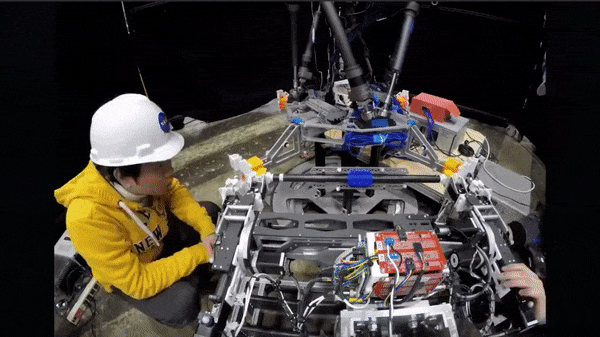
Could robots help power NASA's quest to return humans to the moon?
A newly NASA-funded project called The Assemblers envisions a swarm of robots putting together solar arrays on the moon's surface — or doing other joint-assembly projects in space, on the moon or on Mars.
A new video — perhaps you can call it a "robo cam" — shows how the assembly would look from a robot's point of view as it examines a structure and targets certain areas for more work. Several time-lapse video clips show robots moving into different positions. For now, they are doing this under the watchful eye of engineers, but over time they will work more autonomously.
Video: Autonomous In-Space Assembly Goal of NASA 'Assembler' Project
Related: NASA Eyes a Moon Rover for Astronauts and Robot Lunar Explorers

The early-stage technology recently received a funding boost — to the tune of $2.5 million over two years — through NASA's Early Career Initiative program. The funding is expected to advance the technology's hardware and software for future consideration.
"The project goal is to increase the technology readiness level for the modular robot, autonomous in-space assembly, and develop a robotic prototype for ground testing," principal investigator James Neilan, a computer engineer at the NASA Langley Research Center in Hampton, Virginia, said in a statement.
By the project's end, Neilan's team plans to create a prototype that can manipulate items by itself to assemble components in a space environment. The robots will work together using task-management software and keep tabs on mistakes by implementing error-detection software to see and address any issues as they arise.
The Assembler robots are a series of stacked platforms with actuators in between the platforms, as well as sensors that help each robot figure out where its components are located. "The team is working on algorithms for software so that the robots could choose how many platforms to stack and the right tool for the task at hand," NASA officials said in the statement.
This project is one of many involving robots that could accompany humans to the moon during the Artemis program, which is scheduled to land humans on the moon in 2024. For example, NASA has a range of companies offering landers and other surface technologies under the Commercial Lunar Payload Services program, which aims to bring cargo and other needed items to the moon's surface for scientific exploration — as well as help humans achieve their own lunar goals.